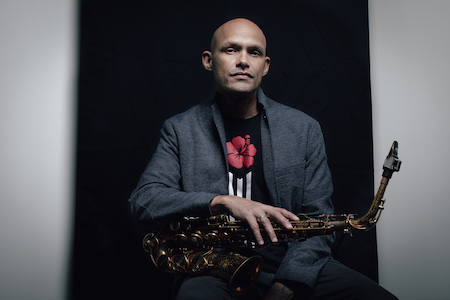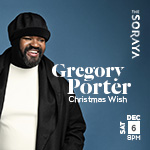Oct 28, 2025 10:47 AM
In Memoriam: Jack DeJohnette, 1942–2025
Jack DeJohnette, a bold and resourceful drummer and NEA Jazz Master who forged a unique vocabulary on the kit over his…

Zenón’s album Música de Las Américas challenges modern notions about who and what America is.
(Photo: Adrien Tillman)While prepping for his latest recording, saxophonist-composer Miguel Zenón had plenty of time to research the history and development of music throughout the American continent, including his native Puerto Rico. His reading list during COVID lockdown in 2020 included such historical tomes as Sebastian Robiou Lamarche’s Tainos y Caribes, Laurent Dubois’ Avengers of the New World, Daniel Immerwahr’s How to Build an Empire and Andy Robinson’s Gold, Oil and Avocados.
The resulting music heard on Música de Las Américas, a byproduct of Zenón’s pandemic history lesson, pays tribute to the diverse indigenous cultures found throughout the American continent while also examining their encounters with European colonists. Along the way, he also challenges modern notions about who and what America is.
“The idea of putting together this project sprung from me thinking about what it means to be American,” Zenón said by phone in August during a break in his weeklong residency at the Village Vanguard. “And for the longest time, for most people, that meant being from the United States. But thinking about it from a broader perspective, it’s more about this idea of America as this massive piece of land that eventually found its way to connect with this other massive piece of land on the other side of the ocean. And I wanted to write music that symbolized the idea of what that meant and how that translated in my head. Am I Puerto Rican? Am I American? Am I Latin American? There’s all these different lines that you could draw.”
Joined by his longtime working quartet of Venezuelan pianist Luis Perdomo, Austrian bassist Hans Glawischnig and Puerto Rican drummer Henry Cole, Zenón also recruited the renowned Puerto Rican ensemble Los Pleneros de La Cresta along with master percussionists Paoli Mejías, Daniel Díaz and Victor Emmanuelli for this ambitious project, his 12th as a leader.
Known for mixing a modernist jazz sensibility with folkloric elements, as he did on 2005’s Jibaro, 2009’s Esta Plena and 2017’s Grammy-nominated Tipico, Zenón has been forging a collective identity with his core group since coming together 17 years ago. “It’s kind of amazing,” he said of the group’s longevity. “We’re comfortable together and they’re comfortable being around the music, so I consider myself lucky because I found something that works for me and apparently works for them, too.”
Zenón and his like-minded crew expertly wed backstory and music on Música de Las Americas. The driving opener, “Taínos y Caribes,” captures the clashing of cultures between two predominant groups in the Caribbean prior to European colonization in its interlocking rhythms. “They were very different societies in nature,” Zenón explained. “The Taínos, from the Greater Antilles islands of Puerto Rico, the Dominican Republic, Haiti, Cuba and Jamaica, were an agricultural-based, very peaceful society, while the Caribes, in the Lesser Antilles islands of Trinidad and Tobago off the coast of Venezuela, were warriors and conquerors. This difference in character has always attracted me. I’ve known about Taínos and Caribes for a long time, but I got deeper into it by reading and finding more about the societies and how they lived at the time. So this tune was trying to portray that type of dynamic of these two societies — coexisting but always rubbing against each other.”
“Taínos y Caribes,” like many of Zenón’s pieces over his career, also deftly obscures the “one” in a manner that recalls the rhythmic experiments of alto saxophonist-composer Steve Coleman with his Five Elements. “Steve is one of my biggest inspirations,” Zenón said. “As a musician, as a saxophonist, I drew heavily on a lot of his ideas. I know him personally, and I’ve talked to him many, many times about his process. He’s been incredibly influential, not only to me, but also to a lot of folks’ imaginations. He’s probably one of the most influential musicians of the last 20, 30 years.”
“Opresíon And Revolucíon,” about the post-colonial uprising in Haiti, is dense and dissonant while drawing on Haitian Voodoo music for a mesmerizing undercurrent, courtesy of master percussionist Paoli Mejías. “I was going for something that was more atonal, more tense,” Zenón said. “I was thinking about the Haitian revolution and what that symbolized for all the Americas, historically, musically, culturally. But I was also thinking about what causes those revolutions, which in most cases is oppression and inequality.”
“Navagando (Las Estrellas Nos Guían),” underscored by churning polyrhythms and featuring vocal call-and-response by Los Pleneros De La Cresta, tells the story of how indigenous groups in the early Americas were able to travel great distances in hand-made wooden vessels by observing the constellations at night.
“That song came together from looking into how this civilization, around the 1500s, traveled from place to place,” explained Zenón. “And it was amazing for me to think that they were traveling these ridiculously long distances in these very rudimentary vessels, basically just using the stars as road maps. And that opens up this whole conversation about what it means to be scientifically advanced, so-called civilized societies. So in writing that song, I looked specifically at some of the star formations that they were dealing with and what they symbolized, and I went through this long process of trying to use some of those star formations to connect to a specific group of notes, a specific group of chords, then build an intro and a melody using that.”
“Imperios” addresses the achievements in astronomy, mathematics, agriculture, architecture and urban planning made by advanced and powerful empires like the Aztecas, Mayas and Incas that ruled vast parts of pre-colonized America.
“Venas Abiertas,” inspired by the 1971 book by Uruguayan writer Eduardo Galeano, Las Venas Abiertas de América Latina (The Open Veins of Latin America), examines the dark relationship between Latin American countries and the corporations that have been exploiting their resources for generations. It’s also a rare instance where Zenón actually wrote lyrics, not intended to be sung but rather to inspire his own instrumental phrasing.
“Sometimes I will write lyrics that probably won’t ever be heard but they help me to write melodies that are more on the lyrical side,” he explained. “And in this case, the melody that I wrote that I play on the saxophone is coming out of this process.”
Another intriguing number on Música de Las Americas had Zenón once again going to the history books for source material. “Bámbula” utilizes an ancient rhythmic cell (a 3-3-2 pattern) that found its way, via Africa, into the Americas, first in Haiti before spreading to Puerto Rican bomba, Cuban tumba and Central American garifuna. It later spread to New Orleans, first in the drumming of enslaved Africans at Congo Square and later appearing in classical composer Louis Moreau Gottschalk’s 1848 Louisiana Creole-flavored composition “Bamboula, Op. 2.”
That same rhythmic quality is evident throughout the New Orleans brass band tradition and Jelly Roll Morton’s syncopated “Spanish tinge” music as well as Professor Longhair’s vivacious “rhumba boogie” style emulated by the likes of Allen Toussaint, Dr. John and Henry Butler.
“This idea of a Bámbula cell, or what people think of as a ‘habanera’ rhythm, that connects all these different places and cultures and musics and then can be traced back that far is, for me, one of the greatest things in music you can find,” Zenón said. “So, I was really enamored with the idea of this ancient cell having all these ramifications.”
While Zenón is shining a light on ancient cells and timeless wisdom on Música de Las Americas, he is quick to point out, “For me, it’s not really about discovery. It just feels good to be able to organize this information and verbalize it musically.” DB

Jack DeJohnette boasted a musical resume that was as long as it was fearsome.
Oct 28, 2025 10:47 AM
Jack DeJohnette, a bold and resourceful drummer and NEA Jazz Master who forged a unique vocabulary on the kit over his…

D’Angelo achieved commercial and critical success experimenting with a fusion of jazz, funk, soul, R&B and hip-hop.
Oct 14, 2025 1:47 PM
D’Angelo, a Grammy-winning R&B and neo-soul singer, guitarist and pianist who exerted a profound influence on 21st…

To see the complete list of nominations for the 2026 Grammy Awards, go to grammy.com.
Nov 11, 2025 12:35 PM
The nominations for the 2026 Grammy Awards are in, with plenty to smile about for the worlds of jazz, blues and beyond.…

Jim McNeely’s singular body of work had a profound and lasting influence on many of today’s top jazz composers in the U.S. and in Europe.
Oct 7, 2025 3:40 PM
Pianist Jim McNeely, one of the most distinguished large ensemble jazz composers of his generation, died Sept. 26 at…

Drummond was cherished by generations of mainstream jazz listeners and bandleaders for his authoritative tonal presence, a defining quality of his style most apparent when he played his instrument unamplified.
Nov 4, 2025 11:39 AM
Ray Drummond, a first-call bassist who appeared on hundreds of albums as a sideman for some of the top names in jazz…






